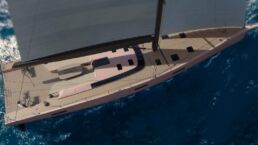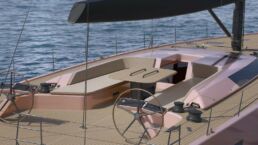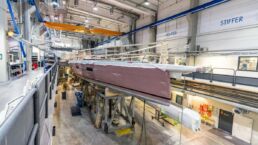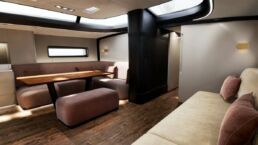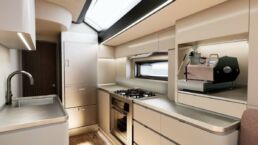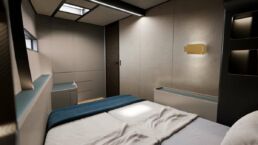The sailing yacht EMMA was commissioned by a seasoned sailor and is envisioned as a high-performance offshore cruiser capable of excelling in Mediterranean regattas.
The elegant and robust design of the 23.99-meter Baltic 80 Custom EMMA is the work of judel/vrolijk, featuring a low freeboard, a beveled reverse bow, and a sleek coachroof designed by Jens Paulus. She stands out with her unique and deliberate appearance, highlighted by a bold old rosé paint scheme, contrasted by a dark black rig and details. She is guaranteed to attract attention both on the water and in port.
The deck plan is clean and spacious. There’s a track for a self-tacking cruising headsail and removable transverse tracks further aft for the racing genoa. A large hatch in the flush foredeck gives access to an extensive sail locker that occupies prime real estate down below – on a typical cruiser-racer, most of that space would be part of the owner’s suite.
The pushpit, stanchions, and pop-up mooring cleats are all titanium to reduce weight and maintenance. The anchoring system is neat and straightforward, with a snug recess in the bowsprit to hold the anchor securely while cruising. It is ready to deploy immediately. A retractable hydraulic mooring winch is on the foredeck for warping operations in the harbor.
The vast, open cockpit offers a generous expanse of open-air living space and a well-judged dual-purpose layout for cruising and racing. It’s designed with equal emphasis on easy handling by a crew of two and efficient operation by an entire racing crew, including maneuvers such as peel sets. Large stowage bins for sheet and halyard tails, set in the aft ends of the coaming with top-hinged hatch lids, are an elegant solution to avoid lines underfoot on the cockpit sole.
The lodging, suitable for six visitors in three cabins and an additional cabin for the permanent crew of two, is arranged to ensure the best weight balance and offers luxurious living space for those on board.
Rather than a complete master suite at the front of the boat, the owner’s living area is located at the back on the right side. This choice is more functional and cozy for a living space used when the boat is in motion, particularly when navigating the open sea.
Beneath the mast are two guest cabins, one large double and another with bunk beds. The living room features a dining area on the starboard side, a deep sofa on the same side, and a navigation station facing the back with a large chart table. The kitchen on the starboard side is open and roomy, connected to the living area.
The crew’s living space, situated at the back of the boat’s port area, is designed for a couple and is as spacious as the double guest cabin forward, complete with its private bathroom.
Designers Jens Paulus and Axel Vervoordt collaborated on the interior design, focusing on using raw carbon elements to highlight the yacht’s high-quality laminate work. Most of the surfaces are either painted or covered in fabric, except for the cabin doors and sole boards, which are made of timber.
Her carbon/epoxy framework is cutting-edge. The main body and bulkhead frames are made of Sprint laminates featuring a foam center and carbon fiber reinforcements. The floor is primarily made of carbon fiber-reinforced prepreg material, a significant portion of it being Nomex. The total weight of the structure is a mere 6.5 tons.
She boasts twin rudders and a lifting keel, all built from a robust prepreg carbon frame that stretches from the keel to the deck, allowing for a draft of 5.3 meters under sail, which is reduced to 3.5 meters when docked. Her mast, boom, and rigging are all constructed from carbon fiber and equipped with a hydraulic system for the furling boom for racing and leisure sailing. The bowsprit features a rotating pad eye for regulatory sails, a manual gennaker furler, and a fixed mainsheet system. Her rear storage area is designed to accommodate a fully operational 3.9m jet RIB tender.
Careful selections have been made to guarantee reliability and optimal performance, with every system managed by Baltic Yachts’ proprietary developed programmable logic controller (PLC). Under regular use, the battery system should be able to power the air conditioning throughout the night without needing a generator. The propulsion system is standard, featuring a 172kW diesel engine with an additional alternator on the engine for battery charging.
SHARING IS CARING - THANK YOU!
About Publisher
 Ahoy, I’m René, the “captain” of this luxury yacht blog, and found my passion for the big ones at the age of 17. I have grown up with sailing since a little child. I have an education in Business Informatics and specialized in digital media solutions (alongside luxury yachts) like Online-Marketing, User Experience Design et cetera. My home port is in Oldenburg, Germany next to Lürssen and Abeking & Rasmussen. More about yachtemoceans
Ahoy, I’m René, the “captain” of this luxury yacht blog, and found my passion for the big ones at the age of 17. I have grown up with sailing since a little child. I have an education in Business Informatics and specialized in digital media solutions (alongside luxury yachts) like Online-Marketing, User Experience Design et cetera. My home port is in Oldenburg, Germany next to Lürssen and Abeking & Rasmussen. More about yachtemoceans
